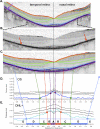The transition zone between healthy and diseased retina in patients with retinitis pigmentosa
- PMID: 20720228
- PMCID: PMC3053270
- DOI: 10.1167/iovs.10-5799
The transition zone between healthy and diseased retina in patients with retinitis pigmentosa
Abstract
Purpose: To describe the structural changes in the transition zone from relatively healthy retinal regions to severely affected regions in patients with retinitis pigmentosa (RP) using frequency domain optical coherence tomography (fdOCT).
Methods: FdOCT line scans of the horizontal meridian were obtained from one eye of 13 patients with RP and 30 control subjects. The patients had normal or near normal foveal sensitivities and visual field diameters ≥10°. Using a computer-aided manual segmentation procedure, the locations at which the outer segment (OS) and outer nuclear layer plus outer plexiform layer (ONL+) thicknesses fell below the 95% confidence interval of the controls were measured, as were the locations at which the OS layer disappeared and the locations at which the ONL+ was reduced to an asymptotically small thickness.
Results: The progression from healthy to severely affected regions followed a common pattern in most patients. Region A, the central region including the foveal center, had normal OS and ONL+ thickness. Region B had abnormal OS but normal ONL+ thickness. Region C had abnormal but measurable OS and ONL+ thicknesses. In Region D, the OS layer disappeared, as did the IS/OS line, and the ONL+ thickness decreased further. In Region E, the ONL+ reached an asymptotic thickness.
Conclusions: The structural changes in the transition zone followed an orderly progression from a thinning of the OS layer, to a thinning of the ONL+, to a loss of the OS layer, to an ONL+ reduced to an asymptotically small level.
Figures






References
-
- Jacobson SG, Aleman TS, Sumaroka A, et al. Disease boundaries in the retina of patients with Usher syndrome caused by MYO7A gene mutations. Invest Ophthalmol Vis Sci. 2009;50:1886–1894 - PubMed
Publication types
MeSH terms
Substances
Grants and funding
LinkOut - more resources
Full Text Sources

